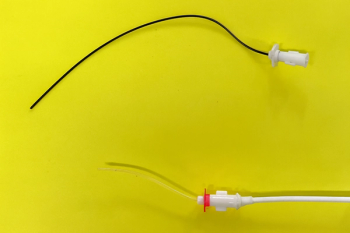
Ethylene glycol induced renal failure (Proceedings)
Ethylene glycol (EG) is the primary component of antifreeze (95% EG), but is also found in paints, lacquers, pharmaceuticals, polishes and cosmetics.
Ethylene glycol (EG) is the primary component of antifreeze (95% EG), but is also found in paints, lacquers, pharmaceuticals, polishes and cosmetics. Antifreeze also has a high concentration of phosphates as rust inhibitors. Fluorscein is added to aid in detecting radiator leaks.
Exposure to ethylene glycol is usually accidental. Dogs may ingest antifreeze from leaking radiators or during changing the antifreeze, or if bottles are left in an accessible location. They may also drink antifreeze placed in the toilet bowl of seasonal homes. Cats may be exposed similarly. Antifreeze that gets on their feet or fur can be consumed during grooming. The lethal dose is 4.4 to 6.6 ml/kg in dogs and 1.5 ml/kg in cats. Cats are far more susceptible to the ill effects of EG. Although exact dose is rarely known in clinical cases, it is likely that sub-lethal doses will cause significant renal impairment.
Metabolism
While EG has many direct effects, its metabolites have a much greater toxic effect on the kidney. Ethylene glycol is a small molecule similar to alcohol, and it readily enters the CNS. Unmetabolized ethylene glycol is eliminated by the kidneys, inducing an osmotic diuresis. However, much ethylene glycol is metabolized by alcohol dehydrogenase in the liver into glycoaldehyde. Glycoaldehyde is further metabolized by aldehyde dehydrogenase to glycolic acid. Although ethylene glycol itself has limited nephrotoxicity, both glycoaldehyde and glycolic acid are profoundly nephrotoxic. These metabolites interfere with energy production. Further metabolism of glycolic acid to oxalic acid leads to calcium oxalate crystal formation, which precipitates in the kidneys, heart and brain.
Clinical signs
There are 3 stages of intoxication with EG. EG is rapidly absorbed from the stomach, with peak levels in 1-3 hours. EG has direct neurologic effects that resemble intoxication (depression, incoordination, ataxia, somnolence, or seizures). There may be vomiting from gastric mucosal irritation. Polydipsia is common in dogs and profound polyuria is common in both dogs and cats, due to high serum osmolality from the substance triggering the thirst mechanism, and an osmotic diuresis from renal elimination of ethylene glycol. These signs may resolve within 12 hours, and many owners interpret this as resolution of the problem and do not seek veterinary attention. The second stage, from 12-24 hours, involves tachycardia and tachypnea, which may be from the metabolic acidosis. Stage 3 is oliguric renal failure, which occurs 24-72 hours post ingestion in dogs, but as early as 12 hours in cats. Signs of uremia and renal pain are typically present.
Diagnosis
Severe high anion gap metabolic acidosis may be present prior to the onset of severe azotemia. The metabolic intermediaries are organic acids (i.e. glycolic acid, oxalic acid) that overwhelm the body's buffer capacity. The anion gap is calculated from the formula:
(Na+ + K+) – (Cl- + HCO3-)
Normal is 16-24. If serum osmolality can be measured, it will be higher than the calculated osmolality, as ethylene glycol is an unmeasured osmole. Serum osmolality is calculated from the formula:
2(Na+ + K+) + (BUN/2.8) + (glucose/18)
when BUN and glucose are measured in mg/dl. Normal is 280-310 mOsm/kg. The difference in osmolal measured and calculated osmolality can be used to estimate the ethylene glycol concentration by multiplying the difference by 6.2.
Azotemia progresses rapidly. Hyperphosphatemia is common and severe, both from the decreased renal excretion and from phosphate-containing rust inhibitors in antifreeze. Hypocalcemia can also be profound, due to the acute rise in phosphorus and precipitation of calcium by oxalate. Ionized hypocalcemia may be significant enough to cause clinical signs of tetany or seizures. Hyperglycemia is also common, from inhibition of glucose metabolism and stress hormone release. CBC changes are usually non-specific.
A classic finding on urinalysis is calcium oxalate crystalluria. The most common form are dihydrate (maltese cross or envelope shaped) but monohydrate forms (picket fence, dumbbell) are seen also. Crystals first appear 3-6 hours after ingestion. Other findings consistent with acute renal failure (isothenuria, glucosuria, hematuria and casts) are common. As calcium oxalate crystals deposit in the kidneys, they become "brighter" both on survey radiographs and ultrasonography. Because of the fluorescein that is added to antifreeze, the urine (or gastric contents) may fluoresce with a Wood's lamp.
A commercial test kit (Allelic Biosystems Ethylene Glycol Test Kit, PRN Pharmacal, Inc., Pensacola, FL) is available to test for EG in blood. The test would be expected to be positive in 1-12 hours post ingestion and potentially up to 24 hours. After 24 hours, most EG has been metabolized and the test may be negative despite severe toxicosis. The test kit also detects propylene glycol, which is a component of many drugs (i.e. diazepam, activated charcoal) and other toxins (metaldehyde snail bait), so pretreatment samples should be utilized. The test kit is not sensitive enough to reliably detect ingestion in cats. A new dipstick-type test is available with a lower (20 ppm vs 50 ppm) detection limit (Kacey, Ashevill, NC), but the accuracy is lower at lower concentrations. Toxicology laboratories can quantify concentrations of ethylene glyol and glycoaldehyde, whereas the cageside test kits give qualitative or semiquantatitive results. However, analysis from a toxicology lab may not be available in a timely fashion.
Treatment
The three components of therapy are decontamination, specific therapy and supportive therapy. If ingestion is detected within 1-2 hours, vomiting should be induced unless the animal is too sedate to protect its airway from aspiration. Activated charcoal has little absorptive capacity for EG.
Specific therapy is targeted at slowing metabolism of EG to its toxic metabolites, allowing urinary excretion of unchanged EG. 4-Methylpyrazole (4-MP, Antizol-Vet, Orphan Medical, Minnetonka, MN) inhibits the action of alcohol dehydrogenase. Administration within 8 hours of ingestion in dogs may prevent renal failure. It does not induce the CNS and respiratory depression common with ethanol. Dosing consists of a loading dose of 20 mg/kg IV, followed by 15 mg/kg IV at 12 and 24 hours, and 5 mg/kg IV at 36 hours. It is not effective in cats at this dose, but higher doses may be used. An initial dose of 125 mg/kg, followed by 31.25 mg/kg at 12, 24, and 36 hours was effective in preventing renal failure when given to cats within 3 hour of ingestion of ethylene glycol.
For cats or when 4-MP is not available for dogs, ethanol acts as a competitive inhibitor of alcohol dehydrogenase. The dose for cats is 5 ml/kg of 20% ethanol IV every 6 hours for 5 treatments, then every 8 hours for 4 treatments, or the same total dose given as a constant rate infusion. For dogs, use 5.5 ml/kg of 20% ethanol IV every 4 hours for 5 treatments, then every 6 hours for 4 treatments (or the same total dose given as a constant rate infusion). Although blood ethanol concentration monitoring could be used, it may not be readily available. Patients with therapeutic concentrations of ethanol will have some evidence of intoxication, and may be severely depressed to obtunded from the treatment. Intensive monitoring of respiratory and CNS function are necessary with ethanol treatment.
Once renal failure has occurred, therapies for ARF are indicated. Initially, most patients are dehydrated and need aggressive IV fluid therapy. However, once the patient is rehydrated, intravenous fluids should be limited if the urine production is diminished (< 1-2 ml/kg/hour). It is my experience that these patients rarely respond to diuretics. Because of the profound metabolic acidosis, sodium bicarbonate therapy may be indicated. Infusion should be slow to decrease the risk of paradoxical CNS acidosis, hypocalcemia and volume overload. If tetany or seizures from hypocalcemia are present, slow intravenous 10% calcium gluconate (0.5-1.5 ml/kg to effect) is indicated but should not be used in the absence of clinical signs due to the risk of calcium-phosphate precipitation in soft tissues. Hyperkalemia is common in oliguric or anuric patients. Hemodialysis or peritoneal dialysis allow management of uremia while allowing time for renal repair.
Outcome
The prognosis if ingestion is treated within 5 hours in dogs and 3 hours in cats is good. After renal failure has developed, the prognosis is grave, with reports of 6% survival rate. With dialysis, recovery of renal function is possible, although it may take months to a year for maximal repair. However, survival rates with hemodialysis are around 20%, compared to much lower success with medical management.
Prevention
Because most ingestion is accidental, prevention consists of increasing community awareness. Proper disposal of used antifreeze and proper storage of unused antifreeze are important, as is rapid clean-up of any spills or leaks. "Safe" antifreeze is available that uses propylene glycol instead of ethylene glycol. Although propylene glycol in large amounts can cause toxicity, the risk of accidental exposure is limited.
References available from the author
Newsletter
From exam room tips to practice management insights, get trusted veterinary news delivered straight to your inbox—subscribe to dvm360.



